Remote data in EJ2 TypeScript Grid control
7 May 202524 minutes to read
In EJ2 TypeScript Grid component, binding remote data is a fundamental aspect that enhances the efficiency of data interaction. This process involves assigning the service data, represented as an instance of DataManager, to the dataSource property of the EJ2 TypeScript Grid component. By doing so, you enable seamless interaction with a remote data source, and this is achieved by specifying the endpoint URL where the data is hosted.
Additionally, leverage the power for data retrieval and operations, enhancing event handling, asynchronous programming, and concurrent value management in EJ2 TypeScript applications.
Custom binding
The custom binding feature in the EJ2 TypeScript Grid enables you to manage your own custom API for handling data processing externally and then binding the resulting data to the Grid. This allows you to implement your own custom data logic to your application’s requirements. When using custom binding, the Grid expects the result of the custom logic to be an object with properties result and count. The result property should contain the data to be displayed in the Grid, while the count property indicates the total number of records in the dataset for your application. To utilize custom binding, you can handle the DataManager. The DataManager integrates seamlessly with the EJ2 TypeScript Grid to manage custom data processing and binding.
The Syncfusion® Grid component offers a range of powerful features for handling grid actions such as paging, grouping, sorting and filtering. These actions trigger the dataStateChange event. The feature for CRUD action such as Create, Read, Update, Delete operations. This action trigger the dataSourceChanged event. This event provides you with the opportunity to manage and manipulate data according to the individual’s interactions.
Using the dataStateChange event
The dataStateChange event is triggered whenever you perform actions that modify the state of the grid’s data, such as changing pages, applying sorting, or grouping. This event provides detailed information about the action performed and the current state of the grid, including parameters like page number, sorting details, and filtering criteria.
To implement the dataStateChange event, follow these steps:
-
Subscribe to the event: In your component code, subscribe to the
dataStateChangeevent using the appropriate event handler function. This function will be executed whenever you interact with the grid. -
Handle data state: Inside the event handler function, you can access the event arguments to determine the individual actions and intentions. The action property of the event arguments indicates the type of action performed (e.g., paging, sorting, grouping).
The
dataStateChangeevent will not be triggered during the initial rendering.
Creating an API service
To configure a server with Syncfusion® EJ2 TypeScript Grid, you need to follow the below steps:
Step 1: Open your terminal and create a new Typescript project using the following command:
git clone https://github.com/SyncfusionExamples/ej2-quickstart-webpack- ej2-quickstartStep 2: Navigate to your project directory and install the required Syncfusion® packages using npm:
cd ej2-quickstart
npm install @syncfusion/ej2-grids --save
npm install @syncfusion/ej2-data --saveStep 3: Add the following styles to the ~/src/styles/styles.css file:
@import '../../node_modules/@syncfusion/ej2-base/styles/bootstrap5.css';
@import '../../node_modules/@syncfusion/ej2-buttons/styles/bootstrap5.css';
@import '../../node_modules/@syncfusion/ej2-calendars/styles/bootstrap5.css';
@import '../../node_modules/@syncfusion/ej2-dropdowns/styles/bootstrap5.css';
@import '../../node_modules/@syncfusion/ej2-inputs/styles/bootstrap5.css';
@import '../../node_modules/@syncfusion/ej2-navigations/styles/bootstrap5.css';
@import '../../node_modules/@syncfusion/ej2-popups/styles/bootstrap5.css';
@import '../../node_modules/@syncfusion/ej2-splitbuttons/styles/bootstrap5.css';
@import '../../node_modules/@syncfusion/ej2-notifications/styles/bootstrap5.css';
@import '../../node_modules/@syncfusion/ej2-grids/styles/bootstrap5.css';Step 4: Install the necessary packages for setting up an Express server:
npm install express body-parser corsStep 5: Install Concurrently to run both the server and client simultaneously:
npm install concurrently --save-devStep 5: Add the following to the tsconfig.json file:
{
"compilerOptions": {
"target": "es2016",
"module": "commonjs",
"rootDir": "./src",
"outDir": "./dist",
"esModuleInterop": true,
"forceConsistentCasingInFileNames": true,
"strict": true,
"skipLibCheck": true
}
}Step 6: Update the scripts section in your package.json to include commands for starting the server and client concurrently:
"scripts": {
"start-server": "node dist/server.js",
"start-client": "webpack-dev-server --mode development",
"start": "concurrently \"node dist/server.js\" \"npm run start-client\"",
"build": "tsc"
}Step 7: Create a dataSource.ts file to represent the data in the src/app folder, like src/app/dataSource.ts.
// datasource.ts
export interface Order {
OrderID: number;
CustomerID: string;
CustomerName: string;
CustomerAddress: string;
ProductName: string;
ProductID: number;
Quantity: string;
}
export const data = createLazyLoadData();
export function createLazyLoadData(): Order[] {
const lazyLoadData: Order[] = []; // Explicitly type lazyLoadData as Order[]
let customerid = ['VINET', 'TOMSP', 'HANAR', 'VICTE', 'SUPRD', 'HANAR', 'CHOPS', 'RICSU', 'WELLI', 'HILAA', 'ERNSH', 'CENTC',
'OTTIK', 'QUEDE', 'RATTC', 'ERNSH', 'FOLKO', 'BLONP', 'WARTH', 'FRANK', 'GROSR', 'WHITC', 'WARTH', 'SPLIR', 'RATTC', 'QUICK', 'VINET',
'MAGAA', 'TORTU', 'MORGK', 'BERGS', 'LEHMS', 'BERGS', 'ROMEY', 'ROMEY', 'LILAS', 'LEHMS', 'QUICK', 'QUICK', 'RICAR', 'REGGC', 'BSBEV',
'COMMI', 'QUEDE', 'TRADH', 'TORTU', 'RATTC', 'VINET', 'LILAS', 'BLONP', 'HUNGO', 'RICAR', 'MAGAA', 'WANDK', 'SUPRD', 'GODOS', 'TORTU',
'OLDWO', 'ROMEY', 'LONEP', 'ANATR', 'HUNGO', 'THEBI', 'DUMON', 'WANDK', 'QUICK', 'RATTC', 'ISLAT', 'RATTC', 'LONEP', 'ISLAT', 'TORTU',
'WARTH', 'ISLAT', 'PERIC', 'KOENE', 'SAVEA', 'KOENE', 'BOLID', 'FOLKO', 'FURIB', 'SPLIR', 'LILAS', 'BONAP', 'MEREP', 'WARTH', 'VICTE',
'HUNGO', 'PRINI', 'FRANK', 'OLDWO', 'MEREP', 'BONAP', 'SIMOB', 'FRANK', 'LEHMS', 'WHITC', 'QUICK', 'RATTC', 'FAMIA'];
let product = ['Chai', 'Chang', 'Aniseed Syrup', 'Chef Anton\'s Cajun Seasoning', 'Chef Anton\'s Gumbo Mix', 'Grandma\'s Boysenberry Spread',
'Uncle Bob\'s Organic Dried Pears', 'Northwoods Cranberry Sauce', 'Mishi Kobe Niku', 'Ikura', 'Queso Cabrales', 'Queso Manchego La Pastora', 'Konbu',
'Tofu', 'Genen Shouyu', 'Pavlova', 'Alice Mutton', 'Carnarvon Tigers', 'Teatime Chocolate Biscuits', 'Sir Rodney\'s Marmalade', 'Sir Rodney\'s Scones',
'Gustaf\'s Knäckebröd', 'Tunnbröd', 'Guaraná Fantástica', 'NuNuCa Nuß-Nougat-Creme', 'Gumbär Gummibärchen', 'Schoggi Schokolade', 'Rössle Sauerkraut',
'Thüringer Rostbratwurst', 'Nord-Ost Matjeshering', 'Gorgonzola Telino', 'Mascarpone Fabioli', 'Geitost', 'Sasquatch Ale', 'Steeleye Stout', 'Inlagd Sill',
'Gravad lax', 'Côte de Blaye', 'Chartreuse verte', 'Boston Crab Meat', 'Jack\'s New England Clam Chowder', 'Singaporean Hokkien Fried Mee', 'Ipoh Coffee',
'Gula Malacca', 'Rogede sild', 'Spegesild', 'Zaanse koeken', 'Chocolade', 'Maxilaku', 'Valkoinen suklaa', 'Manjimup Dried Apples', 'Filo Mix', 'Perth Pasties',
'Tourtière', 'Pâté chinois', 'Gnocchi di nonna Alice', 'Ravioli Angelo', 'Escargots de Bourgogne', 'Raclette Courdavault', 'Camembert Pierrot', 'Sirop d\'érable',
'Tarte au sucre', 'Vegie-spread', 'Wimmers gute Semmelknödel', 'Louisiana Fiery Hot Pepper Sauce', 'Louisiana Hot Spiced Okra', 'Laughing Lumberjack Lager', 'Scottish Longbreads',
'Gudbrandsdalsost', 'Outback Lager', 'Flotemysost', 'Mozzarella di Giovanni', 'Röd Kaviar', 'Longlife Tofu', 'Rhönbräu Klosterbier', 'Lakkalikööri', 'Original Frankfurter grüne Soße'];
let customername = ['Maria', 'Ana Trujillo', 'Antonio Moreno', 'Thomas Hardy', 'Christina Berglund', 'Hanna Moos', 'Frédérique Citeaux', 'Martín Sommer', 'Laurence Lebihan', 'Elizabeth Lincoln',
'Victoria Ashworth', 'Patricio Simpson', 'Francisco Chang', 'Yang Wang', 'Pedro Afonso', 'Elizabeth Brown', 'Sven Ottlieb', 'Janine Labrune', 'Ann Devon', 'Roland Mendel', 'Aria Cruz', 'Diego Roel',
'Martine Rancé', 'Maria Larsson', 'Peter Franken', 'Carine Schmitt', 'Paolo Accorti', 'Lino Rodriguez', 'Eduardo Saavedra', 'José Pedro Freyre', 'André Fonseca', 'Howard Snyder', 'Manuel Pereira',
'Mario Pontes', 'Carlos Hernández', 'Yoshi Latimer', 'Patricia McKenna', 'Helen Bennett', 'Philip Cramer', 'Daniel Tonini', 'Annette Roulet', 'Yoshi Tannamuri', 'John Steel', 'Renate Messner', 'Jaime Yorres',
'Carlos González', 'Felipe Izquierdo', 'Fran Wilson', 'Giovanni Rovelli', 'Catherine Dewey', 'Jean Fresnière', 'Alexander Feuer', 'Simon Crowther', 'Yvonne Moncada', 'Rene Phillips', 'Henriette Pfalzheim',
'Marie Bertrand', 'Guillermo Fernández', 'Georg Pipps', 'Isabel de Castro', 'Bernardo Batista', 'Lúcia Carvalho', 'Horst Kloss', 'Sergio Gutiérrez', 'Paula Wilson', 'Maurizio Moroni', 'Janete Limeira', 'Michael Holz',
'Alejandra Camino', 'Jonas Bergulfsen', 'Jose Pavarotti', 'Hari Kumar', 'Jytte Petersen', 'Dominique Perrier', 'Art Braunschweiger', 'Pascale Cartrain', 'Liz Nixon', 'Liu Wong', 'Karin Josephs', 'Miguel Angel Paolino',
'Anabela Domingues', 'Helvetius Nagy', 'Palle Ibsen', 'Mary Saveley', 'Paul Henriot', 'Rita Müller', 'Pirkko Koskitalo', 'Paula Parente', 'Karl Jablonski', 'Matti Karttunen', 'Zbyszek Piestrzeniewicz'];
let customeraddress = ['507 - 20th Ave. E.\r\nApt. 2A', '908 W. Capital Way', '722 Moss Bay Blvd.', '4110 Old Redmond Rd.', '14 Garrett Hill', 'Coventry House\r\nMiner Rd.', 'Edgeham Hollow\r\nWinchester Way',
'4726 - 11th Ave. N.E.', '7 Houndstooth Rd.', '59 rue de l\'Abbaye', 'Luisenstr. 48', '908 W. Capital Way', '722 Moss Bay Blvd.', '4110 Old Redmond Rd.', '14 Garrett Hill', 'Coventry House\r\nMiner Rd.', 'Edgeham Hollow\r\nWinchester Way',
'7 Houndstooth Rd.', '2817 Milton Dr.', 'Kirchgasse 6', 'Sierras de Granada 9993', 'Mehrheimerstr. 369', 'Rua da Panificadora, 12', '2817 Milton Dr.', 'Mehrheimerstr. 369'];
let quantityperunit= ['10 boxes x 20 bags', '24 - 12 oz bottles', '12 - 550 ml bottles', '48 - 6 oz jars', '36 boxes', '12 - 8 oz jars', '12 - 1 lb pkgs.', '12 - 12 oz jars', '18 - 500 g pkgs.', '12 - 200 ml jars',
'1 kg pkg.', '10 - 500 g pkgs.', '2 kg box', '40 - 100 g pkgs.', '24 - 250 ml bottles', '32 - 500 g boxes', '20 - 1 kg tins', '16 kg pkg.', '10 boxes x 12 pieces', '30 gift boxes', '24 pkgs. x 4 pieces', '24 - 500 g pkgs.', '12 - 250 g pkgs.',
'12 - 355 ml cans', '20 - 450 g glasses', '100 - 250 g bags'];
let OrderID = 10248;
for (let i = 0; i < 100; i++) {
lazyLoadData.push({
'OrderID': OrderID + i,
'CustomerID': customerid[Math.floor(Math.random() * customerid.length)],
'CustomerName': customername[Math.floor(Math.random() * customername.length)],
'CustomerAddress': customeraddress[Math.floor(Math.random() * customeraddress.length)],
'ProductName': product[Math.floor(Math.random() * product.length)],
'ProductID': i,
'Quantity': quantityperunit[Math.floor(Math.random() * quantityperunit.length)]
});
}
return lazyLoadData;
}Step 8: Create server.ts file to set up a basic Express server:
import express, { Request, Response } from "express";
import { data, createLazyLoadData } from './app/datasource'; // Adjust path as necessary
const bodyParser = require('body-parser');
const cors = require('cors');
// Generate the data
const app = express();
app.use(cors({
origin: '*', // Update to the correct frontend origin
credentials: true
}));
app.use(bodyParser.json());
// Root route
app.get('/', (req:Request, res:Response) => {
res.send('Server is running');
});
// all records
app.get('/orders', function (req: Request, res:Response) {
res.json({ result: data, count: data.length });
});
const port = xxxx;// Here xxxx denotes the port number.
app.listen(port, () => {
console.log(`Server running on http://localhost:${port}`);
});Step 9: Create an orderService.ts file inside the src folder (e.g., src/orderService.ts) to handle CRUD operations and grid actions using Syncfusion’s® DataManager:
import { DataManager, Query } from "@syncfusion/ej2-data";
export class OrderService {
}
export {};
const baseUrl = "http://localhost:xxxx/orders"; // Here xxxx denotes the port number.
let gridData:DataManager;
// Apply paging
const applyPaging = (query:Query, state: { take: number; skip: number; })=> {
// Check if both 'take' and 'skip' values are available
if (state.take && state.skip) {
// Calculate pageSkip and pageTake values to get pageIndex and pageSize
const pageSkip = state.skip / state.take + 1;
const pageTake = state.take;
query.page(pageSkip, pageTake);
}
// If if only 'take' is available and 'skip' is 0, apply paging for the first page.
else if (state.skip === 0 && state.take) {
query.page(1, state.take);
}
}
export function getOrders(state:any, action:any) {
const query = new Query();
// page
applyPaging(query, state)
query.isCountRequired = true
return fetch(baseUrl)
.then(res => res.json())
.then(data => {
// Create a DataManager instance with your fetched data
gridData = new DataManager(data.result);
// Execute local data operations using the provided query
const result = gridData.executeLocal(query);
// Return the result along with the count of total records
return {
result: result, // Result of the data
count: (result as any).count // Total record count based on fetched data length
};
});
}Step 10: In your app.ts, import and use the Syncfusion® Grid component. Use the orderService to fetch and manipulate data.
import { DataSourceChangedEventArgs, DataStateChangeEventArgs, Grid } from '@syncfusion/ej2-grids';
import { getOrders, addRecord, updateRecord, deleteRecord } from '../orderService';
import { Page} from '@syncfusion/ej2-grids';
Grid.Inject(Page);
interface CustomDataStateChangeEventArgs extends DataStateChangeEventArgs {
query?: Query;
skip?:number;
take?:number;
}
const state:CustomDataStateChangeEventArgs= { skip: 0, take: 12,query:query};
let grid: Grid = new Grid({
allowPaging: true,
created:created,
dataStateChange: dataStateChange,
columns: [
{ field: 'OrderID', isPrimaryKey:true,headerText: 'Order ID', textAlign: 'Right', width: 120, type: 'number' },
{ field: 'CustomerName', width: 140, headerText: 'Customer Name', type: 'string' },
{ field: 'ProductID', headerText: 'Product ID' ,width: 120 },
{ field: 'ProductName', headerText: 'Product Name', width: 140}
],
height: 315
});
grid.appendTo('#Grid');
// triggers at initial render of the Grid
function created() {
// initial state needs to be sent manually
dataStateChange(state);
}
function dataStateChange (state:DataStateChangeEventArgs) {
const query = grid.getDataModule().generateQuery();
getOrders(state, query).then((result) => {
grid.dataSource = result.result; // Assign the result to the data property
});
}Step 11: Finally, you can start both the server and client concurrently using the start script.
npm run build
npm startReplace https://localhost:xxxx/orders with the actual URL of your API endpoint that provides the data in a consumable format (e.g., JSON).
Handling filtering operation
When filtering operation is performed in the grid, the dataStateChange event is triggered, providing access to the following referenced arguments within the event.
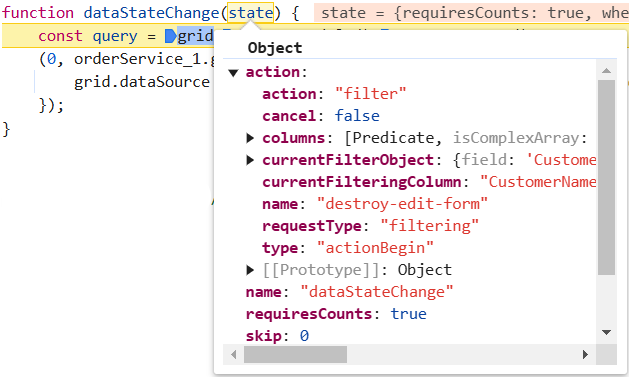
You can change the new grid data state of filter action as follows:
// Apply filtering
const applyFiltering = (query:Query, filter:Filter)=> {
// Check if filter columns are specified
if (filter.columns && filter.columns.length) {
// Apply filtering for each specified column
for (let i = 0; i < filter.columns.length; i++) {
const field = filter.columns[i].field;
const operator = filter.columns[i].operator;
const value = filter.columns[i].value;
query.where(field, operator, value);
}
}
else {
// Apply filtering based on direct filter conditions
for (let i = 0; i < filter.length; i++) {
const { fn, e } = filter[i];
if (fn === 'onWhere') {
query.where(e as string);
}
}
}
}
/** GET all data from the server */
export function getOrders(state:any, action:any) {
const query = new Query();
// filter
if (state.where) {
applyFiltering(query, action.queries);
}
query.isCountRequired = true
// Request the data from server using fetch
return fetch(baseUrl)
.then(res => res.json())
.then(data => {
// Create a DataManager instance with your fetched data
const dataManager = new DataManager(data.result);
// Execute local data operations using the provided query
const result = dataManager.executeLocal(query);
// Return the result along with the count of total records
return {
result: result, // Result of the data
count: (result as any).count // Total record count based on fetched data length
};
});
}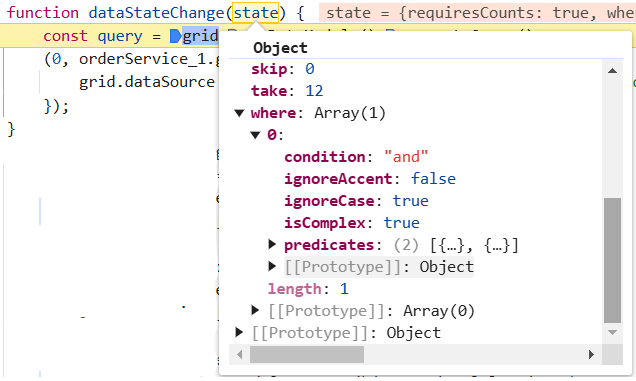
When filtering multiple values, you can get the predicates as arguments in the dataStateChange event. You can create your predicate execution based on the predicates values.
Handling searching operation
When performing a search operation in the grid, the dataStateChange event is triggered, allowing access to the following referenced arguments within the event
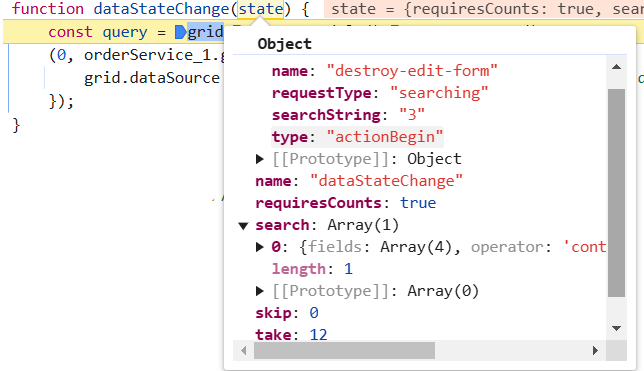
You can change the new grid data state of search action as follows:
// Apply searching
const applySearching = (query:Query, search:Search[])=> {
// Check if a search operation is requested
if (search && search.length > 0) {
// Extract the search key and fields from the search array
const { fields, key } = search[0];
// perform search operation using the field and key on the query
query.search(key, fields);
}
}
/** GET all data from the server */
export function getOrders(state:any, action:any) {
const query = new Query();
// search
if (state.search) {
applySearching(query, state.search);
};
query.isCountRequired = true
// Request the data from server using fetch
return fetch(baseUrl)
.then(res => res.json())
.then(data => {
// Create a DataManager instance with your fetched data
const dataManager = new DataManager(data.result);
// Execute local data operations using the provided query
const result = dataManager.executeLocal(query);
// Return the result along with the count of total records
return {
result: result, // Result of the data
count: (result as any).count // Total record count based on fetched data length
};
});
}Handling sorting operation
When sorting operation is performed in the grid, the dataStateChange event is triggered, and within this event, you can access the following referenced arguments.

When performing multi-column sorting, you can get the below referred arguments in the dataStateChange event.

You can change the new grid data state of sort action as follows:
// Apply sorting
const applySorting = (query:Query, sorted:sortInfo[]) =>{
// Check if sorting data is available
if (sorted && sorted.length > 0) {
// Iterate through each sorting info
sorted.forEach(sort => {
// Get the sort field name either by name or field
const sortField = sort.name || sort.field;
// Perform sort operation using the query based on the field name and direction
query.sortBy(sortField, sort.direction);
});
}
}
/** GET all data from the server */
export function getOrders(state:any, action:any) {
const query = new Query();
// sort
if (state.sorted) {
state.sorted.length ? applySorting(query, state.sorted) :
// initial sorting
state.sorted.columns.length ? applySorting(query, state.sorted.columns) : null
}
query.isCountRequired = true
// Request the data from server using fetch
return fetch(baseUrl)
.then(res => res.json())
.then(data => {
// Create a DataManager instance with your fetched data
const dataManager = new DataManager(data.result);
// Execute local data operations using the provided query
const result = dataManager.executeLocal(query);
// Return the result along with the count of total records
return {
result: result, // Result of the data
count: (result as any).count // Total record count based on fetched data length
};
});
}Handling paging operation
When paging operation is performed in the grid, the dataStateChange event is triggered, and within this event, you can access the following referenced arguments.
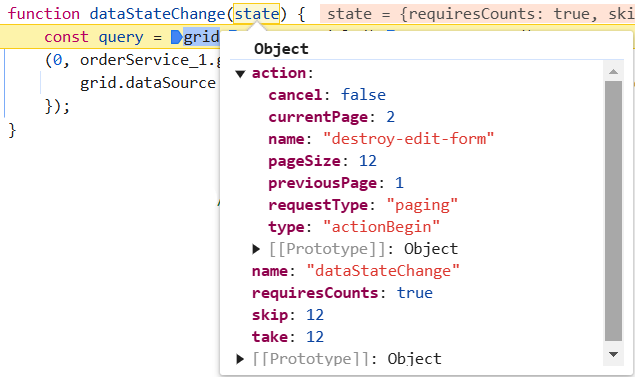
You can change the new grid data state of page action as follows:
// Apply paging
const applyPaging = (query:Query, state: { take: number; skip: number; })=> {
// Check if both 'take' and 'skip' values are available
if (state.take && state.skip) {
// Calculate pageSkip and pageTake values to get pageIndex and pageSize
const pageSkip = state.skip / state.take + 1;
const pageTake = state.take;
query.page(pageSkip, pageTake);
}
// If if only 'take' is available and 'skip' is 0, apply paging for the first page.
else if (state.skip === 0 && state.take) {
query.page(1, state.take);
}
}
/** GET all data from the server */
export function getOrders(state:any, action:any) {
const query = new Query();
// page
applyPaging(query, state)
query.isCountRequired = true
// Request the data from server using fetch
return fetch(baseUrl)
.then(res => res.json())
.then(data => {
// Create a DataManager instance with your fetched data
const dataManager = new DataManager(data.result);
// Execute local data operations using the provided query
const result = dataManager.executeLocal(query);
// Return the result along with the count of total records
return {
result: result, // Result of the data
count: (result as any).count // Total record count based on fetched data length
};
});
}Handling grouping operation
When grouping operation is performed in the grid, the dataStateChange event is triggered, providing access to the following referenced arguments within the event.

You can change the new grid data state of group action as follows:
// Apply grouping
const applyGrouping = (query:Query, group:string[]) =>{
// Check if sorting data is available
if (group.length > 0) {
// Iterate through each group info
group.forEach((column: string) => {
// perform group operation using the column on the query
query.group(column);
});
}
}
/** GET all data from the server */
export function getOrders(state:any, action:any) {
const query = new Query();
// grouping
if (state.group) {
state.group.length ? applyGrouping(query, state.group) :
// initial grouping
state.group.columns.length ? applyGrouping(query, state.group.columns) : null
}
query.isCountRequired = true
// Request the data from server using fetch
return fetch(baseUrl)
.then(res => res.json())
.then(data => {
// Create a DataManager instance with your fetched data
const dataManager = new DataManager(data.result);
// Execute local data operations using the provided query
const result = dataManager.executeLocal(query);
// Return the result along with the count of total records
return {
result: result, // Result of the data
count:(result as any).count // Total record count based on fetched data length
};
});
}
- In order to utilize group actions, it is necessary to manage the sorting query within your service.
Lazy load grouping
In EJ2 TypeScript, lazy loading refers to the technique of loading data dynamically when they are needed, instead of loading everything upfront. Lazy load grouping allows you to load and display grouped data efficiently by fetching only the required data on demand.
To enable this feature, you need to set the groupSettings.enableLazyLoading property to true. Also, you need to manage the state based on the initial grid action as follows.
const groupSettings:object = { enableLazyLoading: true, columns: ['ProductName'], showGroupedColumn: true, };
const state:DataStateChangeEventArgs = { skip:0, take: 12, group: groupSettings as string[]};Based on the initial state, you can get the arguments as shown below
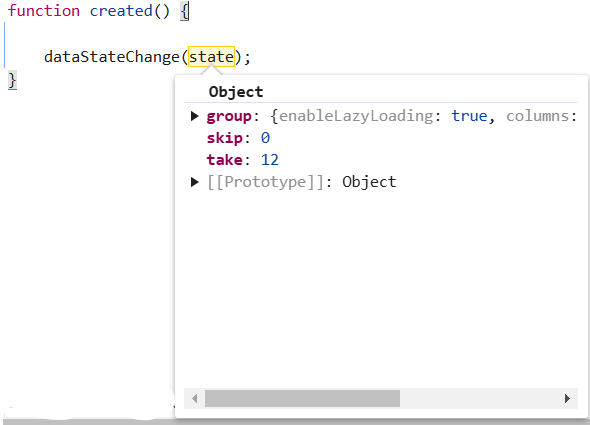
You can change the grid state as follows:
// Apply grouping
const applyGrouping = (query:Query, group:any) =>{
// Check if sorting data is available
if (group.length > 0) {
// Iterate through each group info
group.forEach((column: string) => {
// perform group operation using the column on the query
query.group(column);
});
}
}
// Apply lazy load grouping
const applyLazyLoad = (query:Query, payload:any) => {
// Configure lazy loading for the main data
if (payload.isLazyLoad) {
query.lazyLoad.push({ key: 'isLazyLoad', value: true });
// If on-demand group loading is enabled, configure lazy loading for grouped data
if (payload.onDemandGroupInfo) {
query.lazyLoad.push({
key: 'onDemandGroupInfo',
value: payload.action.lazyLoadQuery,
});
}
}
}
/** GET all data from the server */
export function getOrders(state:any, action:any) {
const query = new Query();
// grouping
if (state.group) {
state.group.length ? applyGrouping(query, state.group) :
// initial grouping
state.group.columns.length ? applyGrouping(query, state.group.columns) : null
}
// lazy load grouping
if (state.group) {
if (state.isLazyLoad) {
applyLazyLoad(query, state)
}
if (state.group.enableLazyLoading) {
query.lazyLoad.push({ key: 'isLazyLoad', value: true })
}
}
query.isCountRequired = true
// Request the data from server using fetch
return fetch(baseUrl)
.then(res => res.json())
.then(data => {
// Create a DataManager instance with your fetched data
const dataManager = new DataManager(data.result);
// Execute local data operations using the provided query
const result = dataManager.executeLocal(query);
// Return the result along with the count of total records
return {
result: result, // Result of the data
count: (result as any).count // Total record count based on fetched data length
};
});
}Further information can be accessed in the respective documentation for lazy load grouping.
Handling CRUD operations
The Grid component provides powerful options for dynamically inserting, deleting, and updating records, enabling you to modify data directly within the grid. This feature is useful when you want to perform CRUD (Create, Read, Update, Delete) operations seamlessly.
Integrating CRUD Operations
To implement CRUD operations using Syncfusion® Grid, follow these steps:
-
Configure grid settings: Set up the necessary grid settings, such as editing, adding, and deleting records. Define the toolbar options to facilitate your interactions.
-
Handle data state changes: Utilize the dataStateChange event to respond to changes in the grid’s data state. This event is triggered whenever you interact with the grid, such as paging or sorting.
-
Execute CRUD operations: Within the event handler for dataSourceChanged, implement logic to handle various CRUD actions based on the action or requestType property of the event arguments.
-
Call endEdit method: After performing CRUD operations (adding, editing, or deleting), call the endEdit method to signal the completion of the operation and update the grid accordingly.
Insert operation
When an insert operation is performed in the grid, the dataSourceChanged event will be triggered, allowing access to the following referenced arguments within the event.
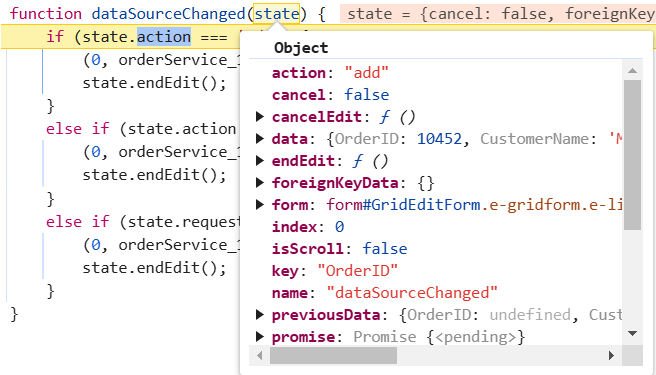
// add
export function addRecord(order:order: Object | Object[] | undefined) {
return fetch(baseUrl , {
method: "post",
headers: { "Content-Type": "application/json" },
body: JSON.stringify({
value: order
})
})
.then((data) => {
return data;
});
}Edit operation
When an edit operation is performed in the grid, the dataSourceChanged event will be triggered, providing access to the following referenced arguments within the event.
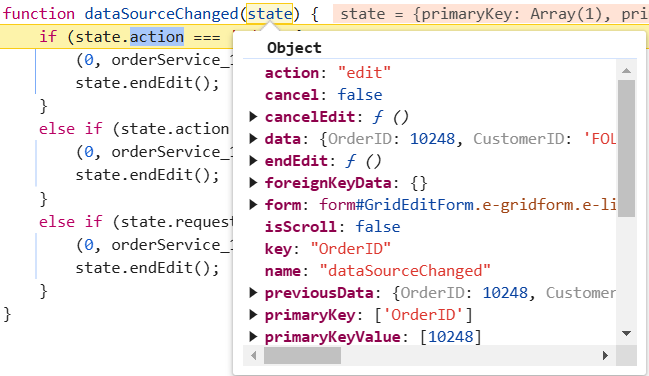
// update
export function updateRecord(order:any) {
return fetch(`${baseUrl}/${order.OrderID}`, {
method: "put",
headers: { "Content-Type": "application/json" },
body: JSON.stringify({
value: order
})
})
.then(data => {
return data;
});
}Delete operation
When a delete operation is performed in the grid, the dataSourceChanged event will be triggered, allowing access to the following referenced arguments within the event.
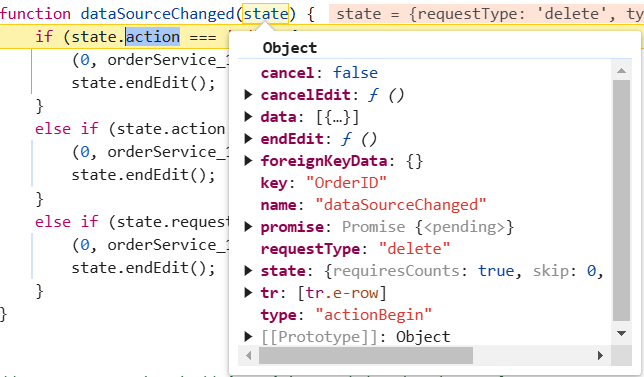
// delete
export function deleteRecord(primaryKey:any) {
return fetch(`${baseUrl}/${primaryKey}`, {
method: "delete",
body: JSON.stringify({
value: primaryKey
})
})
.then(data => {
return data;
});
}The following example demonstrates how to bind custom data to handle grid actions and CRUD operation.
import { DataSourceChangedEventArgs, DataStateChangeEventArgs, Grid ,SortSettingsModel,FilterSettingsModel} from '@syncfusion/ej2-grids';
import { getOrders, addRecord, updateRecord, deleteRecord } from '../orderService';
import { Page, Filter, Sort, Group, LazyLoadGroup, Toolbar, Edit, Search } from '@syncfusion/ej2-grids';
Grid.Inject(Page, Filter, Sort, Group, LazyLoadGroup, Toolbar, Edit, Search);
interface CustomDataStateChangeEventArgs extends DataStateChangeEventArgs {
sort?: SortSettingsModel;
filter?: FilterSettingsModel;
}
const groupSettings: object= { enableLazyLoading: true, columns: ['ProductName'], showGroupedColumn: true, };
const filterSettings: object = { columns: [{ field: 'CustomerName', matchCase: false, operator: 'startswith', predicate: 'and', value: 'Maria' }] };
const sortSettings: object = { columns: [{ field: 'ProductID', direction: 'Descending' }] }
const state:CustomDataStateChangeEventArgs= { skip: 0, take: 12, group: groupSettings as string[],sort: sortSettings,filter: filterSettings};
let grid: Grid = new Grid({
allowPaging: true,
allowFiltering:true,
allowSorting:true,
allowGrouping:true,
created:created,
groupSettings:groupSettings,
sortSettings:sortSettings,
filterSettings:filterSettings,
dataStateChange: dataStateChange,
dataSourceChanged: dataSourceChanged,
editSettings: { allowEditing: true, allowAdding: true, allowDeleting: true },
toolbar: ['Add', 'Edit', 'Delete', 'Update', 'Cancel','Search'],
columns: [
{ field: 'OrderID', isPrimaryKey:true,headerText: 'Order ID', textAlign: 'Right', width: 120, type: 'number' },
{ field: 'CustomerName', width: 140, headerText: 'Customer Name', type: 'string' },
{ field: 'ProductID', headerText: 'Product ID' ,width: 120 },
{ field: 'ProductName', headerText: 'Product Name', width: 140}
],
height: 315
});
grid.appendTo('#Grid');
// triggers at initial render of the Grid
function created() {
// initial state needs to be sent manually
dataStateChange(state);
}
function dataStateChange (state:DataStateChangeEventArgs) {
const query = grid.getDataModule().generateQuery();
getOrders(state, query).then((result) => {
grid.dataSource = result.result; // Assign the result to the data property
});
}
function dataSourceChanged (state:DataSourceChangedEventArgs) {
if (state.action === 'add') {
addRecord(state.data); (state as any).endEdit();
} else if (state.action === 'edit') {
updateRecord(state.data); (state as any).endEdit();
} else if (state.requestType === 'delete') {
deleteRecord((state as any).data[0].OrderID); (state as any).endEdit();
}
}<!DOCTYPE html>
<html lang="en">
<head>
<title>EJ2 Grid</title>
<meta charset="utf-8" />
<meta name="viewport" content="width=device-width, initial-scale=1.0" />
<meta name="description" content="Typescript Grid Control" />
<meta name="author" content="Syncfusion" />
<link href="https://cdn.syncfusion.com/ej2/32.1.19/ej2-base/styles/bootstrap5.css" rel="stylesheet" />
<link href="https://cdn.syncfusion.com/ej2/32.1.19/ej2-grids/styles/bootstrap5.css" rel="stylesheet" />
<link href="https://cdn.syncfusion.com/ej2/32.1.19/ej2-buttons/styles/bootstrap5.css" rel="stylesheet" />
<link href="https://cdn.syncfusion.com/ej2/32.1.19/ej2-popups/styles/bootstrap5.css" rel="stylesheet" />
<link href="https://cdn.syncfusion.com/ej2/32.1.19/ej2-richtexteditor/styles/bootstrap5.css" rel="stylesheet" />
<link href="https://cdn.syncfusion.com/ej2/32.1.19/ej2-navigations/styles/bootstrap5.css" rel="stylesheet" />
<link href="https://cdn.syncfusion.com/ej2/32.1.19/ej2-dropdowns/styles/bootstrap5.css" rel="stylesheet" />
<link href="https://cdn.syncfusion.com/ej2/32.1.19/ej2-lists/styles/bootstrap5.css" rel="stylesheet" />
<link href="https://cdn.syncfusion.com/ej2/32.1.19/ej2-inputs/styles/bootstrap5.css" rel="stylesheet" />
<link href="https://cdn.syncfusion.com/ej2/32.1.19/ej2-calendars/styles/bootstrap5.css" rel="stylesheet" />
<link href="https://cdn.syncfusion.com/ej2/32.1.19/ej2-notifications/styles/bootstrap5.css" rel="stylesheet" />
<link href="https://cdn.syncfusion.com/ej2/32.1.19/ej2-splitbuttons/styles/bootstrap5.css" rel="stylesheet" />
<style>
#loader {
color: #008cff;
height: 40px;
left: 45%;
position: absolute;
top: 45%;
width: 30%;
}
</style>
<script src="https://cdn.syncfusion.com/ej2/syncfusion-helper.js" type ="text/javascript"></script>
</head>
<body>
<div id='loader'>Loading....</div>
<div id='container'>
<div id='Grid'></div>
</div>
</body>
</html>@import '../../node_modules/@syncfusion/ej2-base/styles/material.css';
@import '../../node_modules/@syncfusion/ej2-buttons/styles/material.css';
@import '../../node_modules/@syncfusion/ej2-calendars/styles/material.css';
@import '../../node_modules/@syncfusion/ej2-dropdowns/styles/material.css';
@import '../../node_modules/@syncfusion/ej2-inputs/styles/material.css';
@import '../../node_modules/@syncfusion/ej2-navigations/styles/material.css';
@import '../../node_modules/@syncfusion/ej2-popups/styles/material.css';
@import '../../node_modules/@syncfusion/ej2-splitbuttons/styles/material.css';
@import '../../node_modules/@syncfusion/ej2-notifications/styles/material.css';
@import '../../node_modules/@syncfusion/ej2-grids/styles/material.css';import express, { Request, Response } from "express";
import { data, createLazyLoadData } from './app/datasource'; // Adjust path as necessary
const bodyParser = require('body-parser');
const cors = require('cors');
// Generate the data
const app = express();
app.use(cors({
origin: '*', // Update to the correct frontend origin
credentials: true
}));
app.use(bodyParser.json());
// Root route
app.get('/', (req:Request, res:Response) => {
res.send('Server is running');
});
// all records
app.get('/orders', function (req: Request, res:Response) {
res.json({ result: data, count: data.length });
});
// insert
app.post('/orders', function (req:Request, res:Response){
data.splice(0, 0, req.body.value);
res.status(200).send('Row Inserted');
});
// get specific records
app.get('/orders/:OrderID', (req:Request, res:Response) => {
const orderID = parseInt(req.params.OrderID, 10);
const order = data.find((d: { OrderID: number; }) => d.OrderID === orderID);
if (order) {
res.json(order);
} else {
res.status(404).send('Order not found');
}
});
// Remove
app.delete('/orders/:OrderID', function (req:Request, res:Response) {
const orderID = parseInt(req.params.OrderID, 10);
const index = data.findIndex((x: { OrderID: number; }) => x.OrderID === orderID);
if (index !== -1) {
data.splice(index, 1);
res.status(200).send('Row Deleted');
} else {
res.status(404).send('Order not found');
}
});
// Update
app.put('/orders/:OrderID', function (req:Request, res:Response) {
const orderID = parseInt(req.params.OrderID, 10);
const index = data.findIndex((x: { OrderID: number; }) => x.OrderID === orderID);
if (index !== -1) {
// Assuming req.body.value contains the updated record with the same OrderID
data[index] = req.body.value;
res.status(200).send('Row Updated');
} else {
res.status(404).send('Order not found');
}
});
const port = xxxx;// Here xxxx denotes the port number.
app.listen(port, () => {
console.log(`Server running on http://localhost:${port}`);
});import { DataManager, Query,Predicate } from "@syncfusion/ej2-data";
export class OrderService {
}
export {};
const baseUrl = "http://localhost:xxxx/orders"; // Here xxxx denotes the port number.
let gridData:DataManager;
interface sortInfo {
name: string
field:string
direction: string
}
interface FilterColumn {
field: string;
operator: string;
value: any;
}
interface Filter {
columns?: FilterColumn[];
length: number;
[index: number]: {
fn: string;
e: string | Predicate;
};
}
interface Search {
length: number;
fields: string[];
key: string;
operator?: string;
ignoreCase?: boolean;
}
// Apply filtering
const applyFiltering = (query:Query, filter:Filter)=> {
// Check if filter columns are specified
if (filter.columns && filter.columns.length) {
// Apply filtering for each specified column
for (let i = 0; i < filter.columns.length; i++) {
const field = filter.columns[i].field;
const operator = filter.columns[i].operator;
const value = filter.columns[i].value;
query.where(field, operator, value);
}
}
else {
// Apply filtering based on direct filter conditions
for (let i = 0; i < filter.length; i++) {
const { fn, e } = filter[i];
if (fn === 'onWhere') {
query.where(e as string);
}
}
}
}
// Apply searching
const applySearching = (query:Query, search:Search[])=> {
// Check if a search operation is requested
if (search && search.length > 0) {
// Extract the search key and fields from the search array
const { fields, key } = search[0];
// perform search operation using the field and key on the query
query.search(key, fields);
}
}
// Apply sorting
const applySorting = (query:Query, sorted:sortInfo[]) =>{
// Check if sorting data is available
if (sorted && sorted.length > 0) {
// Iterate through each sorting info
sorted.forEach((sort) => {
// Get the sort field name either by name or field
const sortField = sort.name || sort.field;
// Perform sort operation using the query based on the field name and direction
query.sortBy(sortField, sort.direction);
});
}
}
// Apply grouping
const applyGrouping = (query:Query, group:string[]) =>{
// Check if sorting data is available
if (group.length > 0) {
// Iterate through each group info
group.forEach((column: string) => {
// perform group operation using the column on the query
query.group(column);
});
}
}
// Apply lazy load grouping
const applyLazyLoad = (query:Query, payload:any) => {
// Configure lazy loading for the main data
if (payload.isLazyLoad) {
query.lazyLoad.push({ key: 'isLazyLoad', value: true });
// If on-demand group loading is enabled, configure lazy loading for grouped data
if (payload.onDemandGroupInfo) {
query.lazyLoad.push({
key: 'onDemandGroupInfo',
value: payload.action.lazyLoadQuery,
});
}
}
}
// Apply paging
const applyPaging = (query:Query, state: { take: number; skip: number; })=> {
// Check if both 'take' and 'skip' values are available
if (state.take && state.skip) {
// Calculate pageSkip and pageTake values to get pageIndex and pageSize
const pageSkip = state.skip / state.take + 1;
const pageTake = state.take;
query.page(pageSkip, pageTake);
}
// If if only 'take' is available and 'skip' is 0, apply paging for the first page.
else if (state.skip === 0 && state.take) {
query.page(1, state.take);
}
}
export function getOrders(state:any, action:any) {
const query = new Query();
// filter
if (state.where) {
applyFiltering(query, action.queries);
}
// search
if (state.search) {
applySearching(query, state.search);
};
// sort
if (state.sorted) {
state.sorted.length ? applySorting(query, state.sorted) :
// initial sorting
state.sorted.columns.length ? applySorting(query, state.sorted.columns) : null
}
// grouping
if (state.group) {
state.group.length ? applyGrouping(query, state.group) :
// initial grouping
state.group.columns.length ? applyGrouping(query, state.group.columns) : null
}
// lazy load grouping
if (state.group) {
if (state.isLazyLoad) {
applyLazyLoad(query, state)
}
if (state.group.enableLazyLoading) {
query.lazyLoad.push({ key: 'isLazyLoad', value: true })
}
}
// page
applyPaging(query, state)
query.isCountRequired = true
return fetch(baseUrl)
.then(res => res.json())
.then(data => {
// Create a DataManager instance with your fetched data
gridData = new DataManager(data.result);
// Execute local data operations using the provided query
const result = gridData.executeLocal(query);
// Return the result along with the count of total records
return {
result: result, // Result of the data
count: (result as any).count // Total record count based on fetched data length
};
});
}
// add
export function addRecord(order: Object | Object[] | undefined) {
return fetch(baseUrl , {
method: "post",
headers: { "Content-Type": "application/json" },
body: JSON.stringify({
value: order
})
})
.then((data) => {
return data;
});
}
// update
export function updateRecord(order:any) {
return fetch(`${baseUrl}/${order.OrderID}`, {
method: "put",
headers: { "Content-Type": "application/json" },
body: JSON.stringify({
value: order
})
})
.then(data => {
return data;
});
}
// delete
export function deleteRecord(primaryKey:any) {
return fetch(`${baseUrl}/${primaryKey}`, {
method: "delete",
body: JSON.stringify({
value: primaryKey
})
})
.then(data => {
return data;
});
}// datasource.ts
export interface Order {
OrderID: number;
CustomerID: string;
CustomerName: string;
CustomerAddress: string;
ProductName: string;
ProductID: number;
Quantity: string;
}
function createLazyLoadData(): Order[] {
const lazyLoadData: Order[] = []; // Explicitly type lazyLoadData as Order[]
let customerid = ['VINET', 'TOMSP', 'HANAR', 'VICTE', 'SUPRD', 'HANAR', 'CHOPS', 'RICSU', 'WELLI', 'HILAA', 'ERNSH', 'CENTC',
'OTTIK', 'QUEDE', 'RATTC', 'ERNSH', 'FOLKO', 'BLONP', 'WARTH', 'FRANK', 'GROSR', 'WHITC', 'WARTH', 'SPLIR', 'RATTC', 'QUICK', 'VINET',
'MAGAA', 'TORTU', 'MORGK', 'BERGS', 'LEHMS', 'BERGS', 'ROMEY', 'ROMEY', 'LILAS', 'LEHMS', 'QUICK', 'QUICK', 'RICAR', 'REGGC', 'BSBEV',
'COMMI', 'QUEDE', 'TRADH', 'TORTU', 'RATTC', 'VINET', 'LILAS', 'BLONP', 'HUNGO', 'RICAR', 'MAGAA', 'WANDK', 'SUPRD', 'GODOS', 'TORTU',
'OLDWO', 'ROMEY', 'LONEP', 'ANATR', 'HUNGO', 'THEBI', 'DUMON', 'WANDK', 'QUICK', 'RATTC', 'ISLAT', 'RATTC', 'LONEP', 'ISLAT', 'TORTU',
'WARTH', 'ISLAT', 'PERIC', 'KOENE', 'SAVEA', 'KOENE', 'BOLID', 'FOLKO', 'FURIB', 'SPLIR', 'LILAS', 'BONAP', 'MEREP', 'WARTH', 'VICTE',
'HUNGO', 'PRINI', 'FRANK', 'OLDWO', 'MEREP', 'BONAP', 'SIMOB', 'FRANK', 'LEHMS', 'WHITC', 'QUICK', 'RATTC', 'FAMIA'];
let product = ['Chai', 'Chang', 'Aniseed Syrup', 'Chef Anton\'s Cajun Seasoning', 'Chef Anton\'s Gumbo Mix', 'Grandma\'s Boysenberry Spread',
'Uncle Bob\'s Organic Dried Pears', 'Northwoods Cranberry Sauce', 'Mishi Kobe Niku', 'Ikura', 'Queso Cabrales', 'Queso Manchego La Pastora', 'Konbu',
'Tofu', 'Genen Shouyu', 'Pavlova', 'Alice Mutton', 'Carnarvon Tigers', 'Teatime Chocolate Biscuits', 'Sir Rodney\'s Marmalade', 'Sir Rodney\'s Scones',
'Gustaf\'s Knäckebröd', 'Tunnbröd', 'Guaraná Fantástica', 'NuNuCa Nuß-Nougat-Creme', 'Gumbär Gummibärchen', 'Schoggi Schokolade', 'Rössle Sauerkraut',
'Thüringer Rostbratwurst', 'Nord-Ost Matjeshering', 'Gorgonzola Telino', 'Mascarpone Fabioli', 'Geitost', 'Sasquatch Ale', 'Steeleye Stout', 'Inlagd Sill',
'Gravad lax', 'Côte de Blaye', 'Chartreuse verte', 'Boston Crab Meat', 'Jack\'s New England Clam Chowder', 'Singaporean Hokkien Fried Mee', 'Ipoh Coffee',
'Gula Malacca', 'Rogede sild', 'Spegesild', 'Zaanse koeken', 'Chocolade', 'Maxilaku', 'Valkoinen suklaa', 'Manjimup Dried Apples', 'Filo Mix', 'Perth Pasties',
'Tourtière', 'Pâté chinois', 'Gnocchi di nonna Alice', 'Ravioli Angelo', 'Escargots de Bourgogne', 'Raclette Courdavault', 'Camembert Pierrot', 'Sirop d\'érable',
'Tarte au sucre', 'Vegie-spread', 'Wimmers gute Semmelknödel', 'Louisiana Fiery Hot Pepper Sauce', 'Louisiana Hot Spiced Okra', 'Laughing Lumberjack Lager', 'Scottish Longbreads',
'Gudbrandsdalsost', 'Outback Lager', 'Flotemysost', 'Mozzarella di Giovanni', 'Röd Kaviar', 'Longlife Tofu', 'Rhönbräu Klosterbier', 'Lakkalikööri', 'Original Frankfurter grüne Soße'];
let customername = ['Maria', 'Ana Trujillo', 'Antonio Moreno', 'Thomas Hardy', 'Christina Berglund', 'Hanna Moos', 'Frédérique Citeaux', 'Martín Sommer', 'Laurence Lebihan', 'Elizabeth Lincoln',
'Victoria Ashworth', 'Patricio Simpson', 'Francisco Chang', 'Yang Wang', 'Pedro Afonso', 'Elizabeth Brown', 'Sven Ottlieb', 'Janine Labrune', 'Ann Devon', 'Roland Mendel', 'Aria Cruz', 'Diego Roel',
'Martine Rancé', 'Maria Larsson', 'Peter Franken', 'Carine Schmitt', 'Paolo Accorti', 'Lino Rodriguez', 'Eduardo Saavedra', 'José Pedro Freyre', 'André Fonseca', 'Howard Snyder', 'Manuel Pereira',
'Mario Pontes', 'Carlos Hernández', 'Yoshi Latimer', 'Patricia McKenna', 'Helen Bennett', 'Philip Cramer', 'Daniel Tonini', 'Annette Roulet', 'Yoshi Tannamuri', 'John Steel', 'Renate Messner', 'Jaime Yorres',
'Carlos González', 'Felipe Izquierdo', 'Fran Wilson', 'Giovanni Rovelli', 'Catherine Dewey', 'Jean Fresnière', 'Alexander Feuer', 'Simon Crowther', 'Yvonne Moncada', 'Rene Phillips', 'Henriette Pfalzheim',
'Marie Bertrand', 'Guillermo Fernández', 'Georg Pipps', 'Isabel de Castro', 'Bernardo Batista', 'Lúcia Carvalho', 'Horst Kloss', 'Sergio Gutiérrez', 'Paula Wilson', 'Maurizio Moroni', 'Janete Limeira', 'Michael Holz',
'Alejandra Camino', 'Jonas Bergulfsen', 'Jose Pavarotti', 'Hari Kumar', 'Jytte Petersen', 'Dominique Perrier', 'Art Braunschweiger', 'Pascale Cartrain', 'Liz Nixon', 'Liu Wong', 'Karin Josephs', 'Miguel Angel Paolino',
'Anabela Domingues', 'Helvetius Nagy', 'Palle Ibsen', 'Mary Saveley', 'Paul Henriot', 'Rita Müller', 'Pirkko Koskitalo', 'Paula Parente', 'Karl Jablonski', 'Matti Karttunen', 'Zbyszek Piestrzeniewicz'];
let customeraddress = ['507 - 20th Ave. E.\r\nApt. 2A', '908 W. Capital Way', '722 Moss Bay Blvd.', '4110 Old Redmond Rd.', '14 Garrett Hill', 'Coventry House\r\nMiner Rd.', 'Edgeham Hollow\r\nWinchester Way',
'4726 - 11th Ave. N.E.', '7 Houndstooth Rd.', '59 rue de l\'Abbaye', 'Luisenstr. 48', '908 W. Capital Way', '722 Moss Bay Blvd.', '4110 Old Redmond Rd.', '14 Garrett Hill', 'Coventry House\r\nMiner Rd.', 'Edgeham Hollow\r\nWinchester Way',
'7 Houndstooth Rd.', '2817 Milton Dr.', 'Kirchgasse 6', 'Sierras de Granada 9993', 'Mehrheimerstr. 369', 'Rua da Panificadora, 12', '2817 Milton Dr.', 'Mehrheimerstr. 369'];
let quantityperunit= ['10 boxes x 20 bags', '24 - 12 oz bottles', '12 - 550 ml bottles', '48 - 6 oz jars', '36 boxes', '12 - 8 oz jars', '12 - 1 lb pkgs.', '12 - 12 oz jars', '18 - 500 g pkgs.', '12 - 200 ml jars',
'1 kg pkg.', '10 - 500 g pkgs.', '2 kg box', '40 - 100 g pkgs.', '24 - 250 ml bottles', '32 - 500 g boxes', '20 - 1 kg tins', '16 kg pkg.', '10 boxes x 12 pieces', '30 gift boxes', '24 pkgs. x 4 pieces', '24 - 500 g pkgs.', '12 - 250 g pkgs.',
'12 - 355 ml cans', '20 - 450 g glasses', '100 - 250 g bags'];
let OrderID = 10248;
for (let i = 0; i < 100; i++) {
lazyLoadData.push({
'OrderID': OrderID + i,
'CustomerID': customerid[Math.floor(Math.random() * customerid.length)],
'CustomerName': customername[Math.floor(Math.random() * customername.length)],
'CustomerAddress': customeraddress[Math.floor(Math.random() * customeraddress.length)],
'ProductName': product[Math.floor(Math.random() * product.length)],
'ProductID': i,
'Quantity': quantityperunit[Math.floor(Math.random() * quantityperunit.length)]
});
}
return lazyLoadData;
}The following screenshot represents the grid action with custom binding
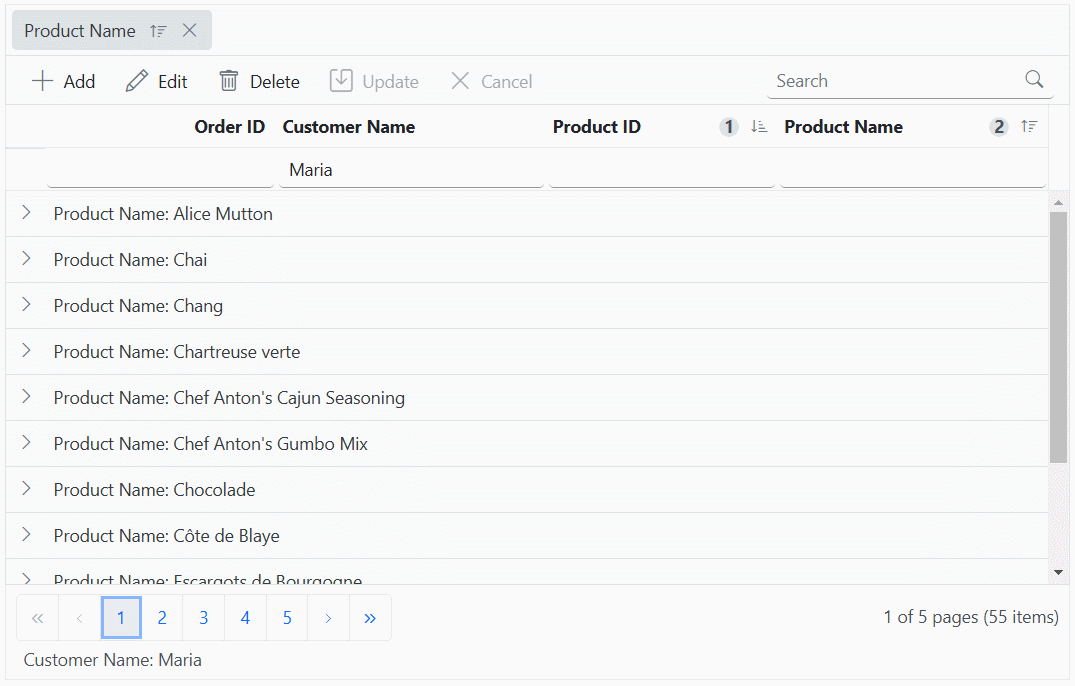
- While working with grid edit operation, defining the isPrimaryKey property of column is a mandatory step. In case the primary key column is not defined, the edit or delete action will take place on the first row of the grid.
- Need to maintain the same instance for all grid actions.
Export all records in client side
Export all records is especially beneficial when dealing with large datasets that need to be exported for offline analysis or sharing.
By default, the Syncfusion® Grid component exports only the records on the current page. However, the Syncfusion® EJ2 TypeScript Grid component allows you to export all records, including those from multiple pages, by configuring the pdfExportProperties and excelExportProperties.
To export all records, including those from multiple pages, configure the pdfExportProperties.dataSource for PDF exporting and excelExportProperties.dataSource for Excel exporting within the toolbarClick event handler. Inside this event, set the dataSource property of pdfExportProperties and excelExportProperties for PDF and Excel exporting to include all records.
Excel Exporting
To export the complete Grid data to Excel document, utilize the excelExportProperties.dataSource when initiating the Excel export. Use the following code snippet to export all records within the Grid:
getOrders(state).then((event) => {
let excelExportProperties = {
dataSource: (event.result as any).result
};
grid.excelExport(excelExportProperties);// Need to call excelExport method of Grid when get the entire data.
});PDF Exporting
To export the complete Grid data to PDF document, utilize the pdfExportProperties.dataSource when initiating the PDF export. Use the following code snippet to export all records within the Grid:
getOrders(state).then((event) => {
let pdfExportProperties = {
dataSource: (event.result as any).result
};
grid.pdfExport(pdfExportProperties);
});For further customization on Grid export, refer to the respective documentation for PDF exporting and Excel exporting
The following code example shows how to export all records in client side:
import { DataStateChangeEventArgs, Grid } from '@syncfusion/ej2-grids';
import { getOrders } from '../orderService';
import { Page, PdfExport, ExcelExport,Toolbar } from '@syncfusion/ej2-grids';
import { ClickEventArgs } from "@syncfusion/ej2-navigations";
Grid.Inject(Page, PdfExport, ExcelExport,Toolbar);
interface CustomDataStateChangeEventArgs extends DataStateChangeEventArgs {
skip:number;
take:number;
}
const state:CustomDataStateChangeEventArgs= { skip: 0, take: 10 };
let grid: Grid = new Grid({
allowPaging: true,
allowExcelExport:true,
allowPdfExport:true,
created:created,
excelExportComplete:exportComplete,
pdfExportComplete:exportComplete,
toolbarClick:toolbarClick,
dataStateChange: dataStateChange,
toolbar: ["ExcelExport", "PdfExport"],
columns: [
{ field: 'OrderID', isPrimaryKey:true,headerText: 'Order ID', textAlign: 'Right', width: 120, type: 'number' },
{ field: 'CustomerName', width: 140, headerText: 'Customer Name', type: 'string' },
{ field: 'ProductID', headerText: 'Product ID' ,width: 120 },
{ field: 'ProductName', headerText: 'Product Name', width: 140}
],
height: 315
});
grid.appendTo('#Grid');
function exportComplete() {
grid.hideSpinner(); // Hide the spinner when export completed.
}
// Triggers at initial render of the Grid.
function created() {
// Initial state needs to be sent manually.
dataStateChange(state);
}
function dataStateChange (state:DataStateChangeEventArgs) {
getOrders(state).then((event) => {
grid.dataSource = event.result; // Assign the result to the dataSource property.
});
}
function toolbarClick(args:ClickEventArgs) {
let state= { action: {}, skip: 0, take: grid.pageSettings.totalRecordsCount };
switch (args.item.text) {
case "PDF Export":
grid.showSpinner(); // Show the spinner when send the post to service.
(state.action as any).isPdfExport = true;
// Fetch the entire data while PDF exporting.
getOrders(state).then((event) => {
let pdfExportProperties = {
dataSource: (event.result as any).result
};
grid.pdfExport(pdfExportProperties); // Need to call pdfExport method of Grid when get the entire data.
});
break;
case "Excel Export":
// Fetch the entire data while Excel exporting.
grid.showSpinner();// Show the spinner when send the post to service.
(state.action as any).isExcelExport = true;
getOrders(state).then((event) => {
let excelExportProperties = {
dataSource: (event.result as any).result
};
grid.excelExport(excelExportProperties);// Need to call excelExport method of Grid when get the entire data.
});
break;
}
}<!DOCTYPE html>
<html lang="en">
<head>
<title>EJ2 Grid</title>
<meta charset="utf-8" />
<meta name="viewport" content="width=device-width, initial-scale=1.0" />
<meta name="description" content="Typescript Grid Control" />
<meta name="author" content="Syncfusion" />
<link href="https://cdn.syncfusion.com/ej2/32.1.19/ej2-base/styles/bootstrap5.css" rel="stylesheet" />
<link href="https://cdn.syncfusion.com/ej2/32.1.19/ej2-grids/styles/bootstrap5.css" rel="stylesheet" />
<link href="https://cdn.syncfusion.com/ej2/32.1.19/ej2-buttons/styles/bootstrap5.css" rel="stylesheet" />
<link href="https://cdn.syncfusion.com/ej2/32.1.19/ej2-popups/styles/bootstrap5.css" rel="stylesheet" />
<link href="https://cdn.syncfusion.com/ej2/32.1.19/ej2-richtexteditor/styles/bootstrap5.css" rel="stylesheet" />
<link href="https://cdn.syncfusion.com/ej2/32.1.19/ej2-navigations/styles/bootstrap5.css" rel="stylesheet" />
<link href="https://cdn.syncfusion.com/ej2/32.1.19/ej2-dropdowns/styles/bootstrap5.css" rel="stylesheet" />
<link href="https://cdn.syncfusion.com/ej2/32.1.19/ej2-lists/styles/bootstrap5.css" rel="stylesheet" />
<link href="https://cdn.syncfusion.com/ej2/32.1.19/ej2-inputs/styles/bootstrap5.css" rel="stylesheet" />
<link href="https://cdn.syncfusion.com/ej2/32.1.19/ej2-calendars/styles/bootstrap5.css" rel="stylesheet" />
<link href="https://cdn.syncfusion.com/ej2/32.1.19/ej2-notifications/styles/bootstrap5.css" rel="stylesheet" />
<link href="https://cdn.syncfusion.com/ej2/32.1.19/ej2-splitbuttons/styles/bootstrap5.css" rel="stylesheet" />
<style>
#loader {
color: #008cff;
height: 40px;
left: 45%;
position: absolute;
top: 45%;
width: 30%;
}
</style>
<script src="https://cdn.syncfusion.com/ej2/syncfusion-helper.js" type ="text/javascript"></script>
</head>
<body>
<div id='loader'>Loading....</div>
<div id='container'>
<div id='Grid'></div>
</div>
</body>
</html>@import '../../node_modules/@syncfusion/ej2-base/styles/material.css';
@import '../../node_modules/@syncfusion/ej2-buttons/styles/material.css';
@import '../../node_modules/@syncfusion/ej2-calendars/styles/material.css';
@import '../../node_modules/@syncfusion/ej2-dropdowns/styles/material.css';
@import '../../node_modules/@syncfusion/ej2-inputs/styles/material.css';
@import '../../node_modules/@syncfusion/ej2-navigations/styles/material.css';
@import '../../node_modules/@syncfusion/ej2-popups/styles/material.css';
@import '../../node_modules/@syncfusion/ej2-splitbuttons/styles/material.css';
@import '../../node_modules/@syncfusion/ej2-notifications/styles/material.css';
@import '../../node_modules/@syncfusion/ej2-grids/styles/material.css';import express, { Request, Response } from "express";
import { data, createLazyLoadData } from './app/datasource';
const bodyParser = require('body-parser');
const cors = require('cors');
// Generate the data.
const app = express();
app.use(cors({
origin: '*', // Update to the correct frontend origin.
credentials: true
}));
app.use(bodyParser.json());
// Root route.
app.get('/', (req:Request, res:Response) => {
res.send('Server is running');
});
// Get all records.
app.get('/orders', function (req: Request, res:Response) {
res.json({ result: data, count: data.length });
});
const port = xxxx;// Here xxxx denotes the port number.
app.listen(port, () => {
console.log(`Server running on http://localhost:${port}`);
});import { DataManager, Query } from "@syncfusion/ej2-data";
export class OrderService {
}
export {};
const baseUrl = "http://localhost:****/orders"; // Here xxxx denotes the port number.
let gridData:DataManager;
// Apply paging.
const applyPaging = (query:Query, state: { take: number; skip: number; })=> {
// Check if both 'take' and 'skip' values are available.
if (state.take && state.skip) {
// Calculate pageSkip and pageTake values to get pageIndex and pageSize.
const pageSkip = state.skip / state.take + 1;
const pageTake = state.take;
query.page(pageSkip, pageTake);
}
// If if only 'take' is available and 'skip' is 0, apply paging for the first page.
else if (state.skip === 0 && state.take) {
query.page(1, state.take);
}
}
export function getOrders(state: any) {
const query = new Query();
applyPaging(query, state)
query.isCountRequired = true
return fetch(baseUrl)
.then(res => res.json())
.then(data => {
// Create a DataManager instance with your fetched data.
gridData = new DataManager(data.result);
// Execute local data operations using the provided query.
const result = gridData.executeLocal(query);
// Return the result along with the count of total records.
return {
result: result, // Result of the data.
count: (result as any).count // Total record count based on fetched data length.
};
});
}export interface Order {
OrderID: number;
CustomerID: string;
CustomerName: string;
CustomerAddress: string;
ProductName: string;
ProductID: number;
Quantity: string;
}
export const data = createLazyLoadData();
export function createLazyLoadData(): Order[] {
const lazyLoadData: Order[] = [];
let customerid = ['VINET', 'TOMSP', 'HANAR', 'VICTE', 'SUPRD', 'HANAR', 'CHOPS', 'RICSU', 'WELLI', 'HILAA', 'ERNSH', 'CENTC',
'OTTIK', 'QUEDE', 'RATTC', 'ERNSH', 'FOLKO', 'BLONP', 'WARTH', 'FRANK', 'GROSR', 'WHITC', 'WARTH', 'SPLIR', 'RATTC', 'QUICK', 'VINET',
'MAGAA', 'TORTU', 'MORGK', 'BERGS', 'LEHMS', 'BERGS', 'ROMEY', 'ROMEY', 'LILAS', 'LEHMS', 'QUICK', 'QUICK', 'RICAR', 'REGGC', 'BSBEV',
'COMMI', 'QUEDE', 'TRADH', 'TORTU', 'RATTC', 'VINET', 'LILAS', 'BLONP', 'HUNGO', 'RICAR', 'MAGAA', 'WANDK', 'SUPRD', 'GODOS', 'TORTU',
'OLDWO', 'ROMEY', 'LONEP', 'ANATR', 'HUNGO', 'THEBI', 'DUMON', 'WANDK', 'QUICK', 'RATTC', 'ISLAT', 'RATTC', 'LONEP', 'ISLAT', 'TORTU',
'WARTH', 'ISLAT', 'PERIC', 'KOENE', 'SAVEA', 'KOENE', 'BOLID', 'FOLKO', 'FURIB', 'SPLIR', 'LILAS', 'BONAP', 'MEREP', 'WARTH', 'VICTE',
'HUNGO', 'PRINI', 'FRANK', 'OLDWO', 'MEREP', 'BONAP', 'SIMOB', 'FRANK', 'LEHMS', 'WHITC', 'QUICK', 'RATTC', 'FAMIA'];
let product = ['Chai', 'Chang', 'Aniseed Syrup', 'Chef Anton\'s Cajun Seasoning', 'Chef Anton\'s Gumbo Mix', 'Grandma\'s Boysenberry Spread',
'Uncle Bob\'s Organic Dried Pears', 'Northwoods Cranberry Sauce', 'Mishi Kobe Niku', 'Ikura', 'Queso Cabrales', 'Queso Manchego La Pastora', 'Konbu',
'Tofu', 'Genen Shouyu', 'Pavlova', 'Alice Mutton', 'Carnarvon Tigers', 'Teatime Chocolate Biscuits', 'Sir Rodney\'s Marmalade', 'Sir Rodney\'s Scones',
'Gustaf\'s Knäckebröd', 'Tunnbröd', 'Guaraná Fantástica', 'NuNuCa Nuß-Nougat-Creme', 'Gumbär Gummibärchen', 'Schoggi Schokolade', 'Rössle Sauerkraut',
'Thüringer Rostbratwurst', 'Nord-Ost Matjeshering', 'Gorgonzola Telino', 'Mascarpone Fabioli', 'Geitost', 'Sasquatch Ale', 'Steeleye Stout', 'Inlagd Sill',
'Gravad lax', 'Côte de Blaye', 'Chartreuse verte', 'Boston Crab Meat', 'Jack\'s New England Clam Chowder', 'Singaporean Hokkien Fried Mee', 'Ipoh Coffee',
'Gula Malacca', 'Rogede sild', 'Spegesild', 'Zaanse koeken', 'Chocolade', 'Maxilaku', 'Valkoinen suklaa', 'Manjimup Dried Apples', 'Filo Mix', 'Perth Pasties',
'Tourtière', 'Pâté chinois', 'Gnocchi di nonna Alice', 'Ravioli Angelo', 'Escargots de Bourgogne', 'Raclette Courdavault', 'Camembert Pierrot', 'Sirop d\'érable',
'Tarte au sucre', 'Vegie-spread', 'Wimmers gute Semmelknödel', 'Louisiana Fiery Hot Pepper Sauce', 'Louisiana Hot Spiced Okra', 'Laughing Lumberjack Lager', 'Scottish Longbreads',
'Gudbrandsdalsost', 'Outback Lager', 'Flotemysost', 'Mozzarella di Giovanni', 'Röd Kaviar', 'Longlife Tofu', 'Rhönbräu Klosterbier', 'Lakkalikööri', 'Original Frankfurter grüne Soße'];
let customername = ['Maria', 'Ana Trujillo', 'Antonio Moreno', 'Thomas Hardy', 'Christina Berglund', 'Hanna Moos', 'Frédérique Citeaux', 'Martín Sommer', 'Laurence Lebihan', 'Elizabeth Lincoln',
'Victoria Ashworth', 'Patricio Simpson', 'Francisco Chang', 'Yang Wang', 'Pedro Afonso', 'Elizabeth Brown', 'Sven Ottlieb', 'Janine Labrune', 'Ann Devon', 'Roland Mendel', 'Aria Cruz', 'Diego Roel',
'Martine Rancé', 'Maria Larsson', 'Peter Franken', 'Carine Schmitt', 'Paolo Accorti', 'Lino Rodriguez', 'Eduardo Saavedra', 'José Pedro Freyre', 'André Fonseca', 'Howard Snyder', 'Manuel Pereira',
'Mario Pontes', 'Carlos Hernández', 'Yoshi Latimer', 'Patricia McKenna', 'Helen Bennett', 'Philip Cramer', 'Daniel Tonini', 'Annette Roulet', 'Yoshi Tannamuri', 'John Steel', 'Renate Messner', 'Jaime Yorres',
'Carlos González', 'Felipe Izquierdo', 'Fran Wilson', 'Giovanni Rovelli', 'Catherine Dewey', 'Jean Fresnière', 'Alexander Feuer', 'Simon Crowther', 'Yvonne Moncada', 'Rene Phillips', 'Henriette Pfalzheim',
'Marie Bertrand', 'Guillermo Fernández', 'Georg Pipps', 'Isabel de Castro', 'Bernardo Batista', 'Lúcia Carvalho', 'Horst Kloss', 'Sergio Gutiérrez', 'Paula Wilson', 'Maurizio Moroni', 'Janete Limeira', 'Michael Holz',
'Alejandra Camino', 'Jonas Bergulfsen', 'Jose Pavarotti', 'Hari Kumar', 'Jytte Petersen', 'Dominique Perrier', 'Art Braunschweiger', 'Pascale Cartrain', 'Liz Nixon', 'Liu Wong', 'Karin Josephs', 'Miguel Angel Paolino',
'Anabela Domingues', 'Helvetius Nagy', 'Palle Ibsen', 'Mary Saveley', 'Paul Henriot', 'Rita Müller', 'Pirkko Koskitalo', 'Paula Parente', 'Karl Jablonski', 'Matti Karttunen', 'Zbyszek Piestrzeniewicz'];
let customeraddress = ['507 - 20th Ave. E.\r\nApt. 2A', '908 W. Capital Way', '722 Moss Bay Blvd.', '4110 Old Redmond Rd.', '14 Garrett Hill', 'Coventry House\r\nMiner Rd.', 'Edgeham Hollow\r\nWinchester Way',
'4726 - 11th Ave. N.E.', '7 Houndstooth Rd.', '59 rue de l\'Abbaye', 'Luisenstr. 48', '908 W. Capital Way', '722 Moss Bay Blvd.', '4110 Old Redmond Rd.', '14 Garrett Hill', 'Coventry House\r\nMiner Rd.', 'Edgeham Hollow\r\nWinchester Way',
'7 Houndstooth Rd.', '2817 Milton Dr.', 'Kirchgasse 6', 'Sierras de Granada 9993', 'Mehrheimerstr. 369', 'Rua da Panificadora, 12', '2817 Milton Dr.', 'Mehrheimerstr. 369'];
let quantityperunit= ['10 boxes x 20 bags', '24 - 12 oz bottles', '12 - 550 ml bottles', '48 - 6 oz jars', '36 boxes', '12 - 8 oz jars', '12 - 1 lb pkgs.', '12 - 12 oz jars', '18 - 500 g pkgs.', '12 - 200 ml jars',
'1 kg pkg.', '10 - 500 g pkgs.', '2 kg box', '40 - 100 g pkgs.', '24 - 250 ml bottles', '32 - 500 g boxes', '20 - 1 kg tins', '16 kg pkg.', '10 boxes x 12 pieces', '30 gift boxes', '24 pkgs. x 4 pieces', '24 - 500 g pkgs.', '12 - 250 g pkgs.',
'12 - 355 ml cans', '20 - 450 g glasses', '100 - 250 g bags'];
let OrderID = 10248;
for (let i = 0; i < 100; i++) {
lazyLoadData.push({
'OrderID': OrderID + i,
'CustomerID': customerid[Math.floor(Math.random() * customerid.length)],
'CustomerName': customername[Math.floor(Math.random() * customername.length)],
'CustomerAddress': customeraddress[Math.floor(Math.random() * customeraddress.length)],
'ProductName': product[Math.floor(Math.random() * product.length)],
'ProductID': i,
'Quantity': quantityperunit[Math.floor(Math.random() * quantityperunit.length)]
});
}
return lazyLoadData;
}Sending additional parameters to the server
The Syncfusion® Grid component allows you to include custom parameters in data requests. This feature is particularly useful when you need to provide additional information to the server enhanced processing.
By utilizing the query property of the grid along with the addParams method of the Query class, you can easily incorporate custom parameters into data requests for every grid action.
To enable custom parameters in data requests for the grid component, follow these steps:
1. Bind the Query Object to the Grid: Assign the initialized query object to the query property of the Syncfusion® Grid component.
2. Initialize the Query Object: Create a new instance of the Query class and use the addParams method to add the custom parameters.
3. Handle Data State Changes: If you need to dynamically update the data based on interactions, implement the dataStateChange event handler to execute the query with the updated state.
4. Execute Data Request: In the service, execute the data request by combining the custom parameters with other query parameters such as paging and sorting.
The following example demonstrates how to send additional parameters to the server.
import { DataStateChangeEventArgs, Grid } from '@syncfusion/ej2-grids';
import { getOrders} from '../orderService';
import { Page} from '@syncfusion/ej2-grids';
import { Query } from '@syncfusion/ej2-data';
Grid.Inject(Page);
interface CustomDataStateChangeEventArgs extends DataStateChangeEventArgs {
query?: Query;
skip?:number;
take?:number;
}
const query:Query= new Query().addParams('Syncfusion_Grid', 'true')
const state:CustomDataStateChangeEventArgs= { skip: 0, take: 12,query:query};
let grid: Grid = new Grid({
allowPaging: true,
created:created,
query:query,
dataStateChange: dataStateChange,
columns: [
{ field: 'OrderID', isPrimaryKey:true,headerText: 'Order ID', textAlign: 'Right', width: 120, type: 'number' },
{ field: 'CustomerName', width: 140, headerText: 'Customer Name', type: 'string' },
{ field: 'ProductID', headerText: 'Product ID' ,width: 120 },
{ field: 'ProductName', headerText: 'Product Name', width: 140}
],
height: 315
});
grid.appendTo('#Grid');
function created() {
dataStateChange(state);
}
function dataStateChange (state:DataStateChangeEventArgs) {
const query = grid.getDataModule().generateQuery();
getOrders(state, query).then((result) => {
grid.dataSource = result.result; // Assign the result to the data property
});
}<!DOCTYPE html>
<html lang="en">
<head>
<title>EJ2 Grid</title>
<meta charset="utf-8" />
<meta name="viewport" content="width=device-width, initial-scale=1.0" />
<meta name="description" content="Typescript Grid Control" />
<meta name="author" content="Syncfusion" />
<link href="https://cdn.syncfusion.com/ej2/32.1.19/ej2-base/styles/bootstrap5.css" rel="stylesheet" />
<link href="https://cdn.syncfusion.com/ej2/32.1.19/ej2-grids/styles/bootstrap5.css" rel="stylesheet" />
<link href="https://cdn.syncfusion.com/ej2/32.1.19/ej2-buttons/styles/bootstrap5.css" rel="stylesheet" />
<link href="https://cdn.syncfusion.com/ej2/32.1.19/ej2-popups/styles/bootstrap5.css" rel="stylesheet" />
<link href="https://cdn.syncfusion.com/ej2/32.1.19/ej2-richtexteditor/styles/bootstrap5.css" rel="stylesheet" />
<link href="https://cdn.syncfusion.com/ej2/32.1.19/ej2-navigations/styles/bootstrap5.css" rel="stylesheet" />
<link href="https://cdn.syncfusion.com/ej2/32.1.19/ej2-dropdowns/styles/bootstrap5.css" rel="stylesheet" />
<link href="https://cdn.syncfusion.com/ej2/32.1.19/ej2-lists/styles/bootstrap5.css" rel="stylesheet" />
<link href="https://cdn.syncfusion.com/ej2/32.1.19/ej2-inputs/styles/bootstrap5.css" rel="stylesheet" />
<link href="https://cdn.syncfusion.com/ej2/32.1.19/ej2-calendars/styles/bootstrap5.css" rel="stylesheet" />
<link href="https://cdn.syncfusion.com/ej2/32.1.19/ej2-notifications/styles/bootstrap5.css" rel="stylesheet" />
<link href="https://cdn.syncfusion.com/ej2/32.1.19/ej2-splitbuttons/styles/bootstrap5.css" rel="stylesheet" />
<style>
#loader {
color: #008cff;
height: 40px;
left: 45%;
position: absolute;
top: 45%;
width: 30%;
}
</style>
<script src="https://cdn.syncfusion.com/ej2/syncfusion-helper.js" type ="text/javascript"></script>
</head>
<body>
<div id='loader'>Loading....</div>
<div id='container'>
<div id='Grid'></div>
</div>
</body>
</html>@import '../../node_modules/@syncfusion/ej2-base/styles/material.css';
@import '../../node_modules/@syncfusion/ej2-buttons/styles/material.css';
@import '../../node_modules/@syncfusion/ej2-calendars/styles/material.css';
@import '../../node_modules/@syncfusion/ej2-dropdowns/styles/material.css';
@import '../../node_modules/@syncfusion/ej2-inputs/styles/material.css';
@import '../../node_modules/@syncfusion/ej2-navigations/styles/material.css';
@import '../../node_modules/@syncfusion/ej2-popups/styles/material.css';
@import '../../node_modules/@syncfusion/ej2-splitbuttons/styles/material.css';
@import '../../node_modules/@syncfusion/ej2-notifications/styles/material.css';
@import '../../node_modules/@syncfusion/ej2-grids/styles/material.css';import express, { Request, Response } from "express";
const { createLazyLoadData } = require('./app/datasource');
const bodyParser = require('body-parser');
const cors = require('cors');
// Generate the data
const app = express();
const data=createLazyLoadData();
app.use(cors({
origin: '*', // Update to the correct frontend origin
credentials: true
}));
app.use(bodyParser.json());
// Root route
app.get('/', (req:Request, res:Response) => {
res.send('Server is running');
});
// all records
app.get('/orders', function (req: Request, res:Response) {
res.json({ result: data, count: data.length });
});
const port = xxxx;// Here xxxx denotes the port number.
app.listen(port, () => {
console.log(`Server running on http://localhost:${port}`);
});import { DataManager, Query,Predicate } from "@syncfusion/ej2-data";
export class OrderService {
}
export {};
const baseUrl = "http://localhost:xxxx/orders"; // Here xxxx denotes the port number.
let gridData:DataManager;
// Apply paging
const applyPaging = (query:Query, state: { take: number; skip: number; })=> {
// Check if both 'take' and 'skip' values are available
if (state.take && state.skip) {
// Calculate pageSkip and pageTake values to get pageIndex and pageSize
const pageSkip = state.skip / state.take + 1;
const pageTake = state.take;
query.page(pageSkip, pageTake);
}
// If if only 'take' is available and 'skip' is 0, apply paging for the first page.
else if (state.skip === 0 && state.take) {
query.page(1, state.take);
}
}
export function getOrders(state:any, action:any) {
const query = new Query();
// page
applyPaging(query, state)
query.isCountRequired = true
query.addParams('Syncfusion_Grid', 'true');
return fetch(baseUrl)
.then(res => res.json())
.then(data => {
// Create a DataManager instance with your fetched data
gridData = new DataManager(data.result);
// Execute local data operations using the provided query
const result = gridData.executeLocal(query);
// Return the result along with the count of total records
return {
result: result, // Result of the data
count: (result as any).count // Total record count based on fetched data length
};
});
}// datasource.ts
export interface Order {
OrderID: number;
CustomerID: string;
CustomerName: string;
CustomerAddress: string;
ProductName: string;
ProductID: number;
Quantity: string;
}
function createLazyLoadData(): Order[] {
const lazyLoadData: Order[] = []; // Explicitly type lazyLoadData as Order[]
let customerid = ['VINET', 'TOMSP', 'HANAR', 'VICTE', 'SUPRD', 'HANAR', 'CHOPS', 'RICSU', 'WELLI', 'HILAA', 'ERNSH', 'CENTC',
'OTTIK', 'QUEDE', 'RATTC', 'ERNSH', 'FOLKO', 'BLONP', 'WARTH', 'FRANK', 'GROSR', 'WHITC', 'WARTH', 'SPLIR', 'RATTC', 'QUICK', 'VINET',
'MAGAA', 'TORTU', 'MORGK', 'BERGS', 'LEHMS', 'BERGS', 'ROMEY', 'ROMEY', 'LILAS', 'LEHMS', 'QUICK', 'QUICK', 'RICAR', 'REGGC', 'BSBEV',
'COMMI', 'QUEDE', 'TRADH', 'TORTU', 'RATTC', 'VINET', 'LILAS', 'BLONP', 'HUNGO', 'RICAR', 'MAGAA', 'WANDK', 'SUPRD', 'GODOS', 'TORTU',
'OLDWO', 'ROMEY', 'LONEP', 'ANATR', 'HUNGO', 'THEBI', 'DUMON', 'WANDK', 'QUICK', 'RATTC', 'ISLAT', 'RATTC', 'LONEP', 'ISLAT', 'TORTU',
'WARTH', 'ISLAT', 'PERIC', 'KOENE', 'SAVEA', 'KOENE', 'BOLID', 'FOLKO', 'FURIB', 'SPLIR', 'LILAS', 'BONAP', 'MEREP', 'WARTH', 'VICTE',
'HUNGO', 'PRINI', 'FRANK', 'OLDWO', 'MEREP', 'BONAP', 'SIMOB', 'FRANK', 'LEHMS', 'WHITC', 'QUICK', 'RATTC', 'FAMIA'];
let product = ['Chai', 'Chang', 'Aniseed Syrup', 'Chef Anton\'s Cajun Seasoning', 'Chef Anton\'s Gumbo Mix', 'Grandma\'s Boysenberry Spread',
'Uncle Bob\'s Organic Dried Pears', 'Northwoods Cranberry Sauce', 'Mishi Kobe Niku', 'Ikura', 'Queso Cabrales', 'Queso Manchego La Pastora', 'Konbu',
'Tofu', 'Genen Shouyu', 'Pavlova', 'Alice Mutton', 'Carnarvon Tigers', 'Teatime Chocolate Biscuits', 'Sir Rodney\'s Marmalade', 'Sir Rodney\'s Scones',
'Gustaf\'s Knäckebröd', 'Tunnbröd', 'Guaraná Fantástica', 'NuNuCa Nuß-Nougat-Creme', 'Gumbär Gummibärchen', 'Schoggi Schokolade', 'Rössle Sauerkraut',
'Thüringer Rostbratwurst', 'Nord-Ost Matjeshering', 'Gorgonzola Telino', 'Mascarpone Fabioli', 'Geitost', 'Sasquatch Ale', 'Steeleye Stout', 'Inlagd Sill',
'Gravad lax', 'Côte de Blaye', 'Chartreuse verte', 'Boston Crab Meat', 'Jack\'s New England Clam Chowder', 'Singaporean Hokkien Fried Mee', 'Ipoh Coffee',
'Gula Malacca', 'Rogede sild', 'Spegesild', 'Zaanse koeken', 'Chocolade', 'Maxilaku', 'Valkoinen suklaa', 'Manjimup Dried Apples', 'Filo Mix', 'Perth Pasties',
'Tourtière', 'Pâté chinois', 'Gnocchi di nonna Alice', 'Ravioli Angelo', 'Escargots de Bourgogne', 'Raclette Courdavault', 'Camembert Pierrot', 'Sirop d\'érable',
'Tarte au sucre', 'Vegie-spread', 'Wimmers gute Semmelknödel', 'Louisiana Fiery Hot Pepper Sauce', 'Louisiana Hot Spiced Okra', 'Laughing Lumberjack Lager', 'Scottish Longbreads',
'Gudbrandsdalsost', 'Outback Lager', 'Flotemysost', 'Mozzarella di Giovanni', 'Röd Kaviar', 'Longlife Tofu', 'Rhönbräu Klosterbier', 'Lakkalikööri', 'Original Frankfurter grüne Soße'];
let customername = ['Maria', 'Ana Trujillo', 'Antonio Moreno', 'Thomas Hardy', 'Christina Berglund', 'Hanna Moos', 'Frédérique Citeaux', 'Martín Sommer', 'Laurence Lebihan', 'Elizabeth Lincoln',
'Victoria Ashworth', 'Patricio Simpson', 'Francisco Chang', 'Yang Wang', 'Pedro Afonso', 'Elizabeth Brown', 'Sven Ottlieb', 'Janine Labrune', 'Ann Devon', 'Roland Mendel', 'Aria Cruz', 'Diego Roel',
'Martine Rancé', 'Maria Larsson', 'Peter Franken', 'Carine Schmitt', 'Paolo Accorti', 'Lino Rodriguez', 'Eduardo Saavedra', 'José Pedro Freyre', 'André Fonseca', 'Howard Snyder', 'Manuel Pereira',
'Mario Pontes', 'Carlos Hernández', 'Yoshi Latimer', 'Patricia McKenna', 'Helen Bennett', 'Philip Cramer', 'Daniel Tonini', 'Annette Roulet', 'Yoshi Tannamuri', 'John Steel', 'Renate Messner', 'Jaime Yorres',
'Carlos González', 'Felipe Izquierdo', 'Fran Wilson', 'Giovanni Rovelli', 'Catherine Dewey', 'Jean Fresnière', 'Alexander Feuer', 'Simon Crowther', 'Yvonne Moncada', 'Rene Phillips', 'Henriette Pfalzheim',
'Marie Bertrand', 'Guillermo Fernández', 'Georg Pipps', 'Isabel de Castro', 'Bernardo Batista', 'Lúcia Carvalho', 'Horst Kloss', 'Sergio Gutiérrez', 'Paula Wilson', 'Maurizio Moroni', 'Janete Limeira', 'Michael Holz',
'Alejandra Camino', 'Jonas Bergulfsen', 'Jose Pavarotti', 'Hari Kumar', 'Jytte Petersen', 'Dominique Perrier', 'Art Braunschweiger', 'Pascale Cartrain', 'Liz Nixon', 'Liu Wong', 'Karin Josephs', 'Miguel Angel Paolino',
'Anabela Domingues', 'Helvetius Nagy', 'Palle Ibsen', 'Mary Saveley', 'Paul Henriot', 'Rita Müller', 'Pirkko Koskitalo', 'Paula Parente', 'Karl Jablonski', 'Matti Karttunen', 'Zbyszek Piestrzeniewicz'];
let customeraddress = ['507 - 20th Ave. E.\r\nApt. 2A', '908 W. Capital Way', '722 Moss Bay Blvd.', '4110 Old Redmond Rd.', '14 Garrett Hill', 'Coventry House\r\nMiner Rd.', 'Edgeham Hollow\r\nWinchester Way',
'4726 - 11th Ave. N.E.', '7 Houndstooth Rd.', '59 rue de l\'Abbaye', 'Luisenstr. 48', '908 W. Capital Way', '722 Moss Bay Blvd.', '4110 Old Redmond Rd.', '14 Garrett Hill', 'Coventry House\r\nMiner Rd.', 'Edgeham Hollow\r\nWinchester Way',
'7 Houndstooth Rd.', '2817 Milton Dr.', 'Kirchgasse 6', 'Sierras de Granada 9993', 'Mehrheimerstr. 369', 'Rua da Panificadora, 12', '2817 Milton Dr.', 'Mehrheimerstr. 369'];
let quantityperunit= ['10 boxes x 20 bags', '24 - 12 oz bottles', '12 - 550 ml bottles', '48 - 6 oz jars', '36 boxes', '12 - 8 oz jars', '12 - 1 lb pkgs.', '12 - 12 oz jars', '18 - 500 g pkgs.', '12 - 200 ml jars',
'1 kg pkg.', '10 - 500 g pkgs.', '2 kg box', '40 - 100 g pkgs.', '24 - 250 ml bottles', '32 - 500 g boxes', '20 - 1 kg tins', '16 kg pkg.', '10 boxes x 12 pieces', '30 gift boxes', '24 pkgs. x 4 pieces', '24 - 500 g pkgs.', '12 - 250 g pkgs.',
'12 - 355 ml cans', '20 - 450 g glasses', '100 - 250 g bags'];
let OrderID = 10248;
for (let i = 0; i < 100; i++) {
lazyLoadData.push({
'OrderID': OrderID + i,
'CustomerID': customerid[Math.floor(Math.random() * customerid.length)],
'CustomerName': customername[Math.floor(Math.random() * customername.length)],
'CustomerAddress': customeraddress[Math.floor(Math.random() * customeraddress.length)],
'ProductName': product[Math.floor(Math.random() * product.length)],
'ProductID': i,
'Quantity': quantityperunit[Math.floor(Math.random() * quantityperunit.length)]
});
}
return lazyLoadData;
}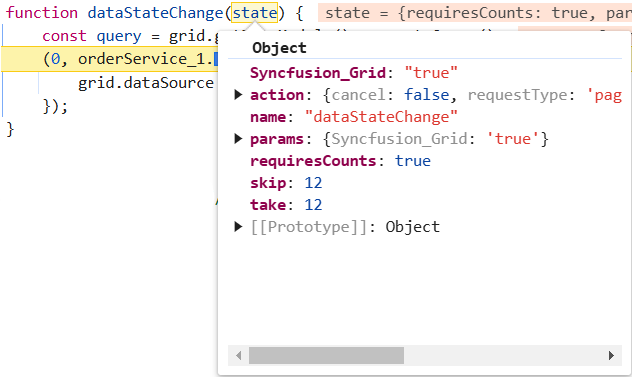
Offline mode
On remote data binding, all grid actions such as paging, sorting, editing, grouping, filtering, etc, will be processed on server-side. To avoid post back for every action, set the grid to load all data on initialization and make the actions process in client-side. To enable this behavior, use the offline property of DataManager.
import { Grid, Page, Sort, Group } from '@syncfusion/ej2-grids';
import { DataManager, ODataAdaptor } from '@syncfusion/ej2-data';
Grid.Inject(Page, Sort, Group);
let data: DataManager = new DataManager({
url: 'https://services.syncfusion.com/js/production/api/Orders',
adaptor: new ODataAdaptor,
offline: true
});
let grid: Grid = new Grid({
dataSource: data,
columns: [
{ field: 'OrderID', headerText: 'Order ID', textAlign: 'Right', width: 120, type: 'number' },
{ field: 'CustomerID', width: 140, headerText: 'Customer ID', type: 'string' },
{ field: 'Freight', headerText: 'Freight', textAlign: 'Right', width: 120, format: 'C' },
{ field: 'OrderDate', headerText: 'Order Date', width: 140, format: 'yMd' }
],
allowPaging: true,
pageSettings: { pageSize: 7 },
allowSorting: true,
allowGrouping: true
});
grid.appendTo('#Grid');<!DOCTYPE html>
<html lang="en">
<head>
<title>EJ2 Grid</title>
<meta charset="utf-8" />
<meta name="viewport" content="width=device-width, initial-scale=1.0" />
<meta name="description" content="Typescript Grid Control" />
<meta name="author" content="Syncfusion" />
<link href="index.css" rel="stylesheet" />
<link href="https://cdn.syncfusion.com/ej2/32.1.19/ej2-base/styles/bootstrap5.css" rel="stylesheet" />
<link href="https://cdn.syncfusion.com/ej2/32.1.19/ej2-grids/styles/bootstrap5.css" rel="stylesheet" />
<link href="https://cdn.syncfusion.com/ej2/32.1.19/ej2-buttons/styles/bootstrap5.css" rel="stylesheet" />
<link href="https://cdn.syncfusion.com/ej2/32.1.19/ej2-popups/styles/bootstrap5.css" rel="stylesheet" />
<link href="https://cdn.syncfusion.com/ej2/32.1.19/ej2-richtexteditor/styles/bootstrap5.css" rel="stylesheet" />
<link href="https://cdn.syncfusion.com/ej2/32.1.19/ej2-navigations/styles/bootstrap5.css" rel="stylesheet" />
<link href="https://cdn.syncfusion.com/ej2/32.1.19/ej2-dropdowns/styles/bootstrap5.css" rel="stylesheet" />
<link href="https://cdn.syncfusion.com/ej2/32.1.19/ej2-lists/styles/bootstrap5.css" rel="stylesheet" />
<link href="https://cdn.syncfusion.com/ej2/32.1.19/ej2-inputs/styles/bootstrap5.css" rel="stylesheet" />
<link href="https://cdn.syncfusion.com/ej2/32.1.19/ej2-calendars/styles/bootstrap5.css" rel="stylesheet" />
<link href="https://cdn.syncfusion.com/ej2/32.1.19/ej2-notifications/styles/bootstrap5.css" rel="stylesheet" />
<link href="https://cdn.syncfusion.com/ej2/32.1.19/ej2-splitbuttons/styles/bootstrap5.css" rel="stylesheet" />
<script src="https://cdnjs.cloudflare.com/ajax/libs/systemjs/0.19.38/system.js"></script>
<script src="systemjs.config.js"></script>
<script src="https://cdn.syncfusion.com/ej2/syncfusion-helper.js" type ="text/javascript"></script>
</head>
<body>
<div id='loader'>Loading....</div>
<div id='container'>
<div id='Grid'></div>
</div>
</body>
</html>Fetch result from the DataManager query using external button
By default, Syncfusion® EJ2 TypeScript Grid automatically binds a remote data source using the DataManager. However, in some scenarios, you may need to fetch data dynamically from the server using a query triggered by an external button. This approach allows greater control over when and how data is loaded into the Grid.
To achieve this, you can use the executeQuery method of DataManager with a Query object. This method allows you to run a custom query and retrieve results dynamically.
The following example demonstrates how to fetch data from the server when an external button is clicked and display a status message indicating the data fetch status:
import { Grid, Page } from '@syncfusion/ej2-grids';
import { DataManager, WebApiAdaptor, Query, ReturnOption } from '@syncfusion/ej2-data';
Grid.Inject(Page);
let SERVICE_URL = 'https://ej2services.syncfusion.com/production/web-services/api/Orders';
let statusMessage = document.getElementById("statusMessage") as HTMLParagraphElement;
let getData = new DataManager({
url: SERVICE_URL,
adaptor: new WebApiAdaptor()
});
let grid = new Grid({
allowPaging:true,
columns: [
{ field: 'OrderID', headerText: 'Order ID', width: 120, textAlign: 'Right' },
{ field: 'CustomerID', headerText: 'Customer ID', width: 160 },
{ field: 'EmployeeID', headerText: 'Employee ID', width: 120, textAlign: 'Right' },
{ field: 'Freight', headerText: 'Freight', width: 150, format: "C2", textAlign: 'Right' },
{ field: 'ShipCountry', headerText: 'Ship Country', width: 150 }
],
dataSource: []
});
grid.appendTo('#Grid');
(document.getElementById("fetchButton") as HTMLElement).addEventListener("click", () => {
statusMessage.textContent = "Fetching data...";
getData.executeQuery(new Query()).then((e: ReturnOption) => {
grid.dataSource = e.result;
statusMessage.textContent = `Data fetched successfully! Total Records: ${e.result.length}`;
}).catch(() => {
statusMessage.textContent = "Error fetching data!";
});
});<!DOCTYPE html>
<html lang="en">
<head>
<title>EJ2 Grid</title>
<meta charset="utf-8" />
<meta name="viewport" content="width=device-width, initial-scale=1.0" />
<meta name="description" content="Typescript Grid Control" />
<meta name="author" content="Syncfusion" />
<link href="index.css" rel="stylesheet" />
<link href="https://cdn.syncfusion.com/ej2/32.1.19/ej2-base/styles/bootstrap5.css" rel="stylesheet" />
<link href="https://cdn.syncfusion.com/ej2/32.1.19/ej2-grids/styles/bootstrap5.css" rel="stylesheet" />
<link href="https://cdn.syncfusion.com/ej2/32.1.19/ej2-buttons/styles/bootstrap5.css" rel="stylesheet" />
<link href="https://cdn.syncfusion.com/ej2/32.1.19/ej2-popups/styles/bootstrap5.css" rel="stylesheet" />
<link href="https://cdn.syncfusion.com/ej2/32.1.19/ej2-richtexteditor/styles/bootstrap5.css" rel="stylesheet" />
<link href="https://cdn.syncfusion.com/ej2/32.1.19/ej2-navigations/styles/bootstrap5.css" rel="stylesheet" />
<link href="https://cdn.syncfusion.com/ej2/32.1.19/ej2-dropdowns/styles/bootstrap5.css" rel="stylesheet" />
<link href="https://cdn.syncfusion.com/ej2/32.1.19/ej2-lists/styles/bootstrap5.css" rel="stylesheet" />
<link href="https://cdn.syncfusion.com/ej2/32.1.19/ej2-inputs/styles/bootstrap5.css" rel="stylesheet" />
<link href="https://cdn.syncfusion.com/ej2/32.1.19/ej2-calendars/styles/bootstrap5.css" rel="stylesheet" />
<link href="https://cdn.syncfusion.com/ej2/32.1.19/ej2-notifications/styles/bootstrap5.css" rel="stylesheet" />
<link href="https://cdn.syncfusion.com/ej2/32.1.19/ej2-splitbuttons/styles/bootstrap5.css" rel="stylesheet" />
<script src="https://cdnjs.cloudflare.com/ajax/libs/systemjs/0.19.38/system.js"></script>
<script src="systemjs.config.js"></script>
<script src="https://cdn.syncfusion.com/ej2/syncfusion-helper.js" type ="text/javascript"></script>
</head>
<body>
<div id='loader'>Loading....</div>
<div id='container'>
<button id="fetchButton">Execute Query</button>
<p id="statusMessage" style="text-align:center;color:red"></p>
<div id="Grid"></div>
</div>
</body>
</html>